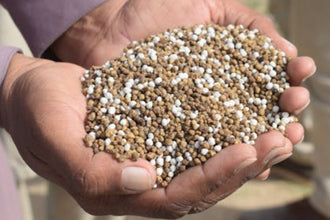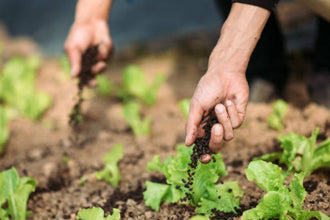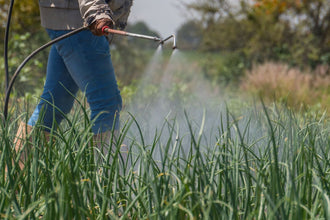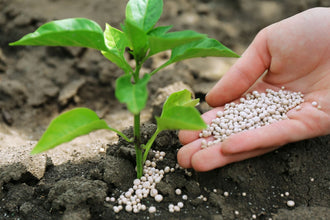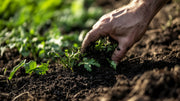
Fertilizer timing makes a huge difference in how well your garden grows. Too many people just throw some plant food around whenever they remember to do it. Then they wonder why their tomatoes look sad or their flowers barely bloom.
Your plants actually need food at specific times, just like you need breakfast in the morning and dinner at night. Feed them at the right time, and you'll see them take off like never before. Get the timing wrong, and you might as well be throwing money in the trash.
Plants go through different stages as they grow. Baby plants need different nutrition than full-grown ones. Spring plants have different needs than fall plants. Once you understand these patterns, your garden will start performing way better than your neighbors' yards.
Understanding Plant Growth Cycles and Nutrient Needs
Plants are pretty predictable when you think about it. They wake up in spring, party hard all summer, then start winding down in fall. Each season brings different nutritional needs, and smart gardeners work with these natural cycles instead of fighting against them.
Most people make the mistake of feeding their plants the same way all year long. That's like eating the same meal for breakfast, lunch, and dinner every single day. Your body wouldn't be happy about that, and neither are your plants.
Spring Awakening and Early Growth
Spring is like coffee time for your plants. They've been sleeping all winter, and now they're ready to wake up and start growing again. This is when they're hungry for nitrogen to build new leaves and stems.
Your cool weather crops like lettuce and peas are the early risers. They start wanting food as soon as the soil thaws out. These guys can handle some cold, so they're ready to eat before your warm weather plants even think about waking up.
Tomatoes and peppers are the late sleepers of the plant world. They won't even consider growing until the soil stays warm consistently. Don't rush them with food too early, or you'll just waste it.
Trees and bushes also start their big growth push in spring. They need energy to grow new branches and leaves after sitting around all winter doing nothing. Give them some food early in spring, and they'll reward you with better growth all season long.
Summer Peak Performance
Summer is when your plants are working their hardest. They're growing, flowering, and making fruit all at the same time. That takes a lot of energy, which means they need more frequent meals.
But here's the tricky part about summer fertilizer timing. You can't just dump food on hot, stressed plants and expect them to be grateful. Hot, dry plants can't absorb nutrients properly. It's like trying to eat a big meal when you're already feeling sick.
Morning feeding works best during hot weather. Plants can soak up the nutrients before the sun gets too intense. Always water after you feed them so the food can actually reach their roots.
Container plants are like teenagers during summer. They eat constantly and always want more food. Their roots are stuck in a small space, so nutrients run out fast. These plants might need feeding every three to four weeks instead of the usual six to eight weeks.
Fall Preparation and Root Development
Fall is when smart plants start getting ready for winter. They slow down their top growth but keep working on their root systems. Cool soil is perfect for root growth, which is why fall feeding focuses on building strong underground systems.
Trees, bushes, and perennial plants really benefit from fall meals. They store up energy during fall that helps them survive winter and come back strong in spring. But don't give them too much nitrogen late in fall. That can make them grow tender new shoots that will just get killed by frost.
Grass is different from other plants in fall. It keeps growing and making food for itself even when the weather gets cool. That's why fall lawn feeding is often more important than spring feeding. Cool season grasses store fall nutrients to fuel their spring green-up.
Seasonal Fertilizer Timing Strategies
Each season has its own rules for feeding plants. Good gardeners learn these rules and use them to their advantage. Fighting against the seasons is a losing battle that wastes time and money.
The key is understanding that calendar dates don't mean much to plants. They care about soil temperature, daylight hours, and moisture levels. A warm March might mean spring feeding time, while a cold April might mean waiting another few weeks.

Early Season Foundation Building
Getting your fertilizer timing right in early season sets up everything else for success. This is when you're laying the groundwork for the whole growing year.
Soil temperature matters way more than what the calendar says. Plants won't use nutrients until their roots are active, and roots don't get active until soil warms up. Feeding cold soil just wastes fertilizer.
Organic fertilizers work great for early season because they release nutrients slowly. As soil microbes wake up and get busy, they gradually make nutrients available to plants. This matches what plants actually need much better than quick-release synthetic stuff.
Getting your soil ready before planting also affects fertilizer timing all season long. Adding compost or aged manure early creates a nutrient foundation that supports plants throughout the growing season. This prep work means you won't need to feed as often later.
Mid-Season Maintenance
Mid-season fertilizer timing is about keeping steady growth going without overdoing it. Most established plants need food every four to six weeks during growing season, but this changes based on what kind of plants you're growing and how they're doing.
Vegetable gardens usually need more attention than flower beds or established plantings. Fast-growing crops like corn, squash, and tomatoes burn through nutrients quickly. You'll see yellow leaves and poor growth if you don't stay on top of feeding them.
Flower gardens have their own timing rules depending on when plants bloom:
-
Early spring flowers need food right after they finish blooming
-
Summer bloomers want regular feeding while they're flowering
-
Fall bloomers benefit from late summer feeding to fuel their show
Late Season Transitions
Late season fertilizer timing requires the most careful attention of the whole year. You want to help plants prepare for winter without causing problems that cold weather can make worse.
Stop heavy nitrogen feeding about six to eight weeks before your first expected frost. Late nitrogen makes plants grow soft, tender shoots that cold weather will damage or kill. Focus on phosphorus and potassium instead, which strengthen plants and improve cold tolerance.
Some plants actually benefit from late season feeding. Root vegetables like carrots and beets keep growing underground even after their tops slow down. Continued feeding improves their flavor and helps them store better.
Plant-Specific Fertilizer Timing
Different types of plants have evolved their own feeding strategies. Understanding these differences helps you fine-tune fertilizer timing for better results in every part of your garden.
Plants in the same family often have similar needs, but there are always exceptions. The key is observing your specific plants and adjusting accordingly.
Vegetable Garden Timing
Vegetable gardens have some of the most demanding fertilizer timing requirements because you're asking plants to grow fast and produce lots of food in a short time.
Leafy greens like lettuce, spinach, and kale need frequent light meals rather than occasional heavy feeding. Their shallow roots can't store much nutrition, so they prefer steady, low-level feeding. Weekly light applications work better than monthly heavy doses.
Fruiting plants like tomatoes, peppers, and eggplants have two distinct feeding phases:
-
Early growth phase - Focus on nitrogen to build strong plant structure
-
Flowering and fruiting phase - Reduce nitrogen and increase phosphorus and potassium
Getting this transition timing wrong leads to plants with beautiful leaves but no fruit.
Root crops have their own special needs. Carrots, beets, radishes, and turnips want phosphorus early for root development, then steady potassium as their roots grow bigger. Too much nitrogen creates gorgeous tops but tiny, poorly shaped roots.
Ornamental Plant Considerations
Flowering plants base their feeding needs around their bloom schedules. This creates some unique timing requirements that differ from vegetable gardening.
Spring bulbs like tulips and daffodils need feeding immediately after their flowers fade. They use their remaining green leaves to collect and store nutrients for next year's show. Miss this window, and next spring's flowers will be disappointing.
Summer annual flowers benefit from regular feeding throughout their blooming period. These plants are working hard to flower continuously all season long, which takes a lot of energy.
Shrubs and trees have longer cycles than annual plants. Their fertilizer timing typically involves two to three applications per year:
-
Early spring for new growth
-
Mid-summer for maintenance
-
Fall for root development and winter preparation
Over-feeding woody plants can actually reduce flowering and fruiting, so less is often more.
Houseplants need completely different fertilizer timing based on indoor conditions. Most indoor plants grow much more slowly than outdoor plants and need less frequent feeding. Winter months usually require no fertilizer at all because low light prevents plants from using nutrients effectively.
Common Fertilizer Timing Mistakes
Even experienced gardeners make timing mistakes that hurt plant performance. Learning to spot and avoid these problems will improve your garden results significantly.
Understanding what not to do is often just as important as knowing what to do. These mistakes are easy to make but also easy to avoid once you know about them.
Over-Fertilizing During Stress Periods
Plants can't use nutrients when they're dealing with drought, extreme temperatures, or disease problems. Feeding stressed plants is like force-feeding someone who already feels sick. It doesn't help and often makes things worse.
Hot summer days create especially challenging conditions for fertilizer timing. High temperatures prevent proper nutrient uptake and can cause fertilizer burn if you're not careful. Morning applications on cloudy days work much better than afternoon feeding in blazing sun.
Disease problems also mess up fertilizer timing. Sick plants can't process nutrients normally, and too much nitrogen can actually make disease problems worse. Get your plants healthy first, then worry about feeding them.
Ignoring Soil Conditions
Your soil's pH level affects how well plants can access nutrients, no matter how perfect your fertilizer timing is. Most plants prefer slightly acidic to neutral soil. Very alkaline or acidic soils lock up nutrients even when your feeding schedule is spot-on.
Soil moisture also impacts fertilizer timing in big ways. Dry soil prevents nutrients from moving to root zones where plants need them. Waterlogged soil lets nutrients wash away before plants can use them. Check soil moisture before every application and adjust your timing accordingly.
Cold soil temperatures slow down both plant growth and nutrient availability. Your fertilizer timing has to account for actual soil temperature, not just what the thermometer says or what date it is. Cold soil means delayed feeding schedules.
Advanced Timing Techniques for Better Results
Once you master basic fertilizer timing, these advanced strategies can take your gardening to the next level. These techniques require more attention but deliver noticeably better results.
Professional growers use these methods because they work. Home gardeners can adapt these same principles for better garden performance.
Split Applications
Instead of dumping all your fertilizer at once, split applications provide steady nutrition over longer periods. This works especially well for nitrogen, which plants use continuously during active growth.
Split applications work great for vegetable gardens. Instead of applying all your season's fertilizer at planting time, divide it into three to four smaller applications throughout the growing season. This matches nutrient availability with what plants actually need much better.
Container plants almost always perform better with split applications. Their restricted root zones can't hold large amounts of nutrients, so frequent small meals work much better than occasional big ones.
Weather-Based Adjustments
Smart fertilizer timing takes weather conditions into account. Rainy periods can wash away surface applications before plants absorb them. Dry spells prevent proper nutrient uptake even when timing is otherwise perfect.
Try to plan fertilizer applications before light rainfall when possible. Gentle rain helps nutrients move into soil without washing them away. Avoid feeding before heavy storms that might cause runoff problems.
Wind conditions matter too. Granular fertilizers need calm conditions for even coverage. Liquid fertilizers can drift in strong winds and miss their target areas completely.
Start Timing Your Feedings Like a Pro
Good fertilizer timing separates successful gardeners from frustrated ones. Your plants depend on you to provide nutrition when they can actually use it, not just when it's convenient for you.
Pay attention to what your plants are telling you. Rapid growth means they need more food. Flowering signals a shift from nitrogen to phosphorus priorities. Slowing fall growth means it's time to stop feeding and let plants get ready for winter.
Ready to give your plants perfectly timed nutrition that works with their natural cycles? Organic fertilizers provide steady, season-long feeding that prevents timing mistakes while building healthier soil. Their slow-release nutrients support better growth year after year, making your garden the envy of the neighborhood.




